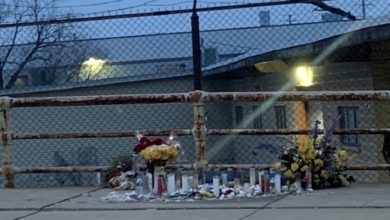On August 5, officials in the Chicago suburb of Dolton acquiesced to some of the demands of family and community activists calling for justice after the police killing of Alexis Wilson. Officials released some body camera footage of the killing of Wilson from early morning July 28. The Mayor of Dolton, Tiffany Henyard, also apologized and walked back a previous statement where she praised the actions of police that led to Wilson’s death.
This reversal on the part of Dolton police happened because of protest. On August 2, family members and community activists mobilized to demand justice for Wilson, a 19-year-old woman who was killed by police days earlier. The action began outside the house of Henyard, where more than 20 police officers from multiple agencies confronted the crowd.
The lack of transparency from Dolton officials and police leaves many questions around the circumstances of Wilson’s killing. Wilson was at the local fast food restaurant Baba’s around 1 a.m. on July 27 when police arrived. Not long after, she was dead and her car had crashed into a building down the street from where the incident began.
The day after the killing, Sean Howard, a spokesperson for Dolton, gave an interview with Fox 32 News where he repeatedly described the car Wilson was in as a deadly weapon.
In the aftermath of the shooting, Dolton officials appeared more concerned with justifying the actions of police than actually providing the public or Wilson’s family with accurate information about the incident. At the time of this writing almost two weeks after the event, the names of the officers involved, including the shooter, have not been released.
At a press conference the day after the killing, Mayor Henyard said of Dolton police: “They did do the right thing. If anything, they have saved the community from any crime that could have or would have happened last night.”
Mayor Henyard’s words were criticized multiple times by organizers that gathered outside her house on August 2. They noted that the Mayor’s statement came well before any investigation had been completed and even before officials had spoken to Wilson’s family.
Dr. La’Shawn Littrice of Make Noize for Change stated: “To not be able to offer your condolences to the family is a slap in the face. This family has not received one phone call or visit from this mayor. Nor has she come out to retract or correct her statement so we need an apology for that. What we also need is justice for the family. We want charges to be brought up on these officers and we want them to be convicted.”
The mayor initially did not meet with protesters or offer an apology to the family. Instead, dozens of armed police officers from multiple departments arrived in front of her home to intimidate protesters. At least one of these officers was carrying an assault-style rifle. These confrontational tactics are emblematic of the aggressive style of policing in Cook County, especially the predominantly Black and Latino suburbs south of the city.
Miracle Boyd, a youth organizer with Good Kids Mad City, expanded how police treat oppressed communities: “Times like these happen all the time and they’re always going to criminalize our Black and Brown youth. Black and Brown women and men in this country are not protected.”
Just days after the protest, the tone from Dolton officials changed. Mayor Henyard issued an apology saying: “The words that I expressed previously were based upon the information at the time and were not meant to overshadow the significance of Ms. Wilson’s life, nor cause additional pain to the Wilson family.” The police chief also screened a video of Wilson’s killing that used body camera and surveillance footage from the incident, and framed the incident as a tragedy for all involved.
The footage released shows Wilson’s car in the drive-through with an officer leaning through the front-passenger window before the car moves and leaves the frame. Alexis Wilson is heard in the footage several times saying that she does not want to leave the car because she was naked, wearing only a robe and top. Police begin reaching into her car, and it appears that a police officer strikes her before her car moves.
After the partial body camera footage was released, the family gathered to give their own press conference. They spoke about how they got more information about the death of Wilson from the local news media than from the police. They called for police to release unedited footage from the body cameras. Alonzo Wilson, the father of Alexis, said: “I do want justice, and I want the lies to stop.”
Organizer Joseph Wilson said: “We are here today because of the murder of Alexis Wilson by Dolton police.” He urged people to “come out here to make sure Dolton police and the Dolton mayor are held accountable for their actions.”
In the context of extreme police impunity in the south suburbs of Chicago, the release of body camera footage and an apology from the mayor is a victory in the movement for justice for Wilson and all victims of police terror. The Better Government Association found that between 2005 and 2020 there were at least 135 police shootings in the suburbs surrounding Chicago, and not a single officer was charged or even disciplined. Dolton itself accounted for nine of these shootings. The struggle for justice for Alexis Wilson will continue.
Feature photo: Protesters gather outside the home of Dolton Mayor Tiffany Henyard. Liberation photo






